Guidance Document
Attachment D_ OT21-2103 Success Stories Guidance Document .docx
[NCSTLTPHIW] Information Collections to Advance State, Tribal, Local and Territorial (STLT) Governmental Agency System Performance, Capacity, and Program Delivery
Guidance Document
OMB: 0920-0879
Attachment D—OT21-2103 Success Stories Guidance Document
 Guide
for Writing a OT21-2103 Success Story
Guide
for Writing a OT21-2103 Success Story

The CDC OT21-2103 Team is collecting success stories that highlight sample achievements of OT21-2103 recipients expending awarded funds and performing their proposed activities in accordance with this funding opportunity. This effort is optional and not required as part of the grant funding agreement.
Background
The purpose of CDC-RFA-OT21-2103: National Initiative to Address COVID-19 Health Disparities Among Populations at High-Risk and Underserved, Including Racial and Ethnic Minority Populations and Rural Communities is to address COVID-19 related health disparities and advance health equity by expanding state, local, US territorial, and freely associated state health department capacity and services.
The intended outcomes are to 1) reduce COVID-19-related health disparities, 2) improve and increase testing and contact tracing among populations at higher risk and that are underserved, including racial and ethnic minority groups and people living in rural communities, and 3) improve state, local, US territorial and freely associated state health department capacity and services to prevent and control COVID-19 infection (or transmission) among populations at higher risk and that are underserved, including racial and ethnic minority groups and people living in rural communities.
Purpose of the OT21-2103 Success Stories: Telling a story of an OT21-2103 recipient’s work
Success stories help highlight achievements and progress of a program or activity. They can document program improvement over time and demonstrate the value of related efforts. The OT21-2103 success stories can be used by recipients, CDC, and others to showcase the work of the recipient.
Note that the story does not have to be based on formal evaluation or measurements of success.
What are the benefits to crafting a success story?
The creation of success stories allows recipients to share their impacts with their peers, partners, and decision makers. It also helps CDC highlight the work performed by OT21-2103 recipients.
Who can submit a OT21-2103 Success Story?
OT21-2103 Program leadership invite recipient staff, partners, consultants, subcontractors, as these individuals typically have a thorough understanding and knowledge of the recipient’s efforts on the OT21-2103 grant. Please be sure to obtain the necessary reviews, approvals, and/or clearance from the recipient organization.
Who is the audience for a OT21-2103 Success Story?
Consider the audience as you write. The audience can include CDC, current and potential partners, decision makers, and funders.
Where should a OT21-2103 Success Story be submitted?
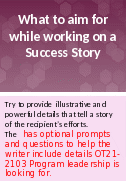 Please
complete the REDCap
form (https://redcap.link/2103successtest)
questions to submit a
success story.
Please
complete the REDCap
form (https://redcap.link/2103successtest)
questions to submit a
success story.
Instructions for Completing the Form
Before completing the form
An optional step to take ahead of entering information or submitting a story is contact the recipient’s project officer or email OT21-2103 Support email ([email protected]) to discuss questions or uncertainties you may have.
Review this guide to thoroughly understand the related request.
While completing the form
This REDCap form (https://redcap.link/2103successtest) should be used to submit stories. Suggestion to use Chrome as the browser for entering success story content and submission of the story.
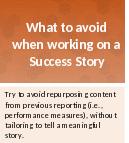
Ensure that you follow this guide and any guidance you may have received from the project officer, OT21-2103 support team, etc.
Refer to the optional prompts and questions through the form to help with drafting responses and content.
Word limits are included.
Each success story may take an average of about 6 hours to develop content and submit the REDCap form.
As you write the responses, keep your audience in mind. Think about how to convey the recipient’s story in a way that matters to your audience and inspires them to support the program’s efforts.
The success story should be more than a list of events or activities. The stories should clearly highlight the value of the event or activities. Good stories answer key questions: What is the problem or what happened? Why should people care? How did the program help? What is the result? Think about showing change and painting a picture of how this change is making a positive difference in people’s lives.
Feel free to draft the responses in a separate tool, like a Word Document, then copy and paste content into the REDCap form (https://redcap.link/2103successtest)once ready to submit.
Select "Save & Return" option to avoid losing work and especially before switching tasks.
Showcasing OT21-2103 achievements
For the OT21-2103 grant, the stories should showcase the recipient’s efforts on the grant by responding to the following questions:
What COVID-19 related health disparity(ies) did the OT21-2103 recipient target to improve capacity and services that address COVID-19 health disparities and advance health equity?
How has the recipient addressed COVID-19 related health disparity(ies) and/or advanced health equity through use of OT21-2103 resources?
What is the impact of the recipient’s efforts addressing COVID-19 health disparities and/or advancing health equity?
Sections and overview of the OT21-2103 form
Form instructions and tips
This section has introductory information to the form, instructions and tips for the submitter.


Please check the box to agree that CDC and partners may use content and materials submitted.

Success Story Background
Success Story Title
Submitters should add a title in the text box. The maximum character limit is 60 characters (including spaces) and will countdown as you enter text.

Challenge, Solution and Impact
Submitters should use the corresponding text boxes to enter their response to the Challenge, Solution and Impact questions.
The maximum character limit for each of the three fields is 800 characters (including spaces). The countdown of characters will update as text is entered into the text box. See examples below for a blank text box with 800 characters remaining and the second text box displays the character countdown of 769 characters after including Challenge, Solution and Impact.


Optional: Submitters can reference the prompts above the text box to help draft their response to the main questions.
Optional:
Submitters can reference the checkbox statements below the text box
to gauge if submitters can elaborate further or highlight additional
details as it pertains to their responses to the main questions.
Submitters can click on the
![]() next to each checkbox statement to help track their reference of the
statement to their response.
next to each checkbox statement to help track their reference of the
statement to their response.
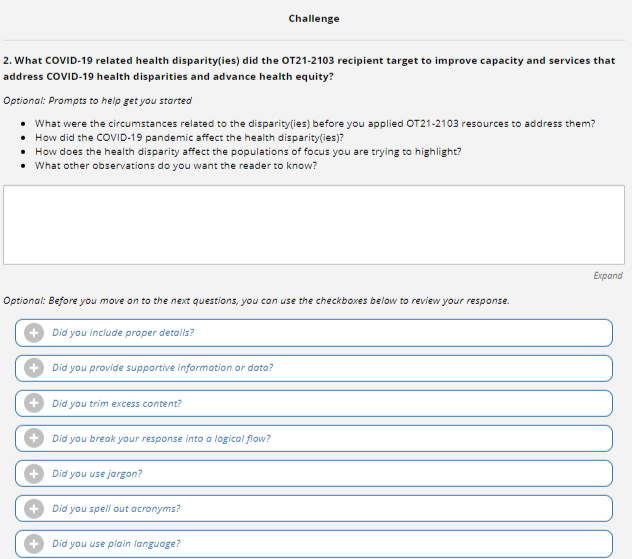
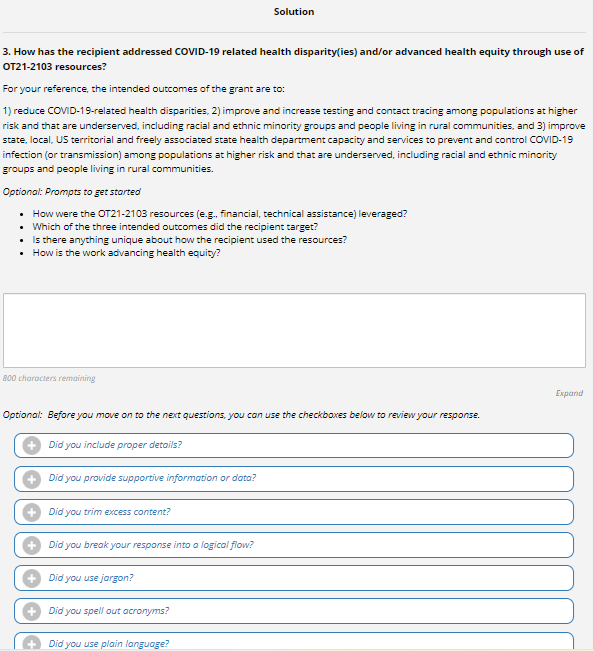
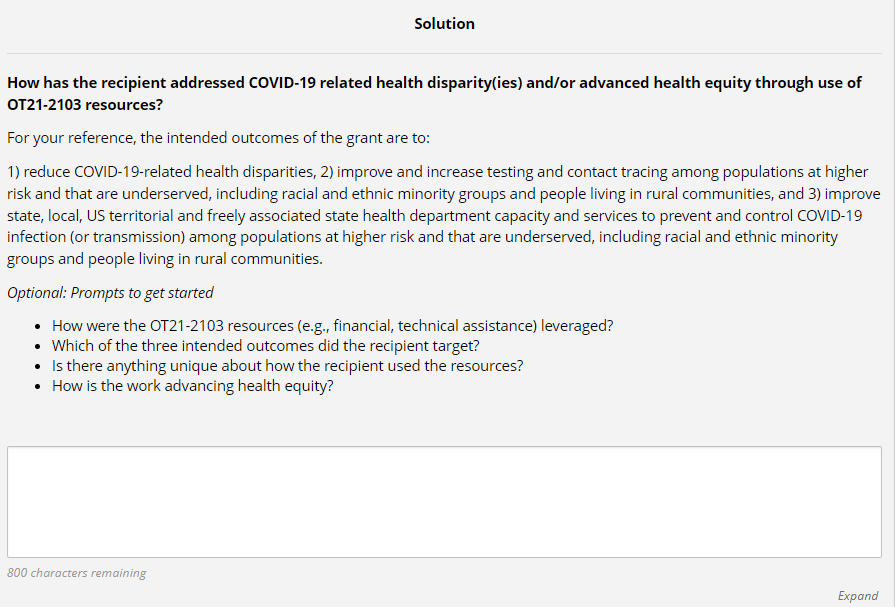
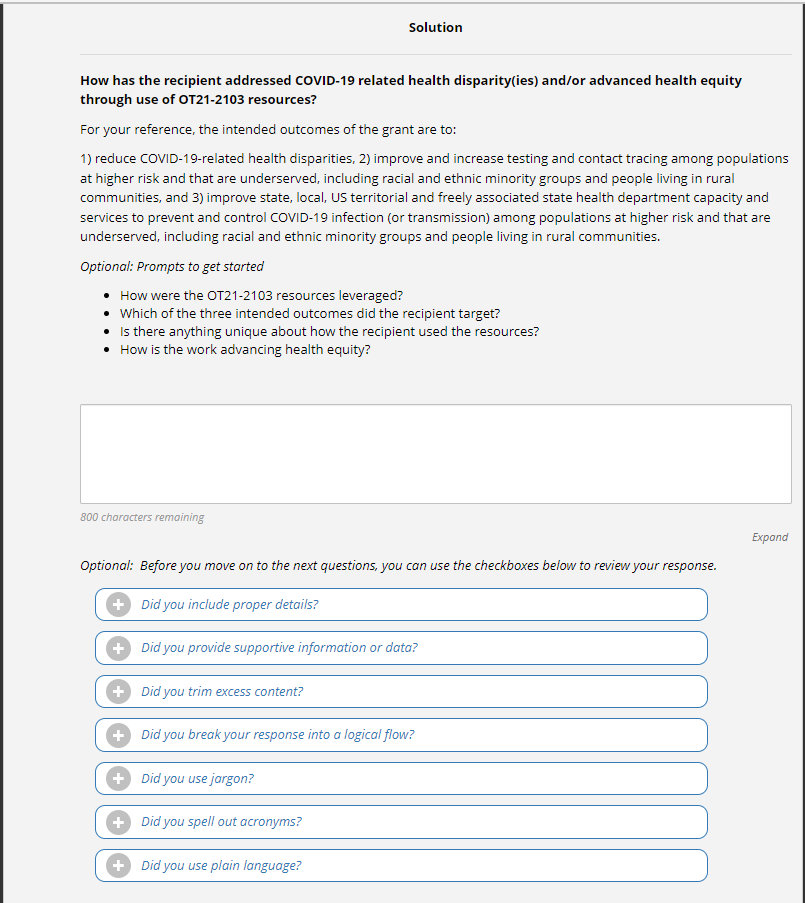
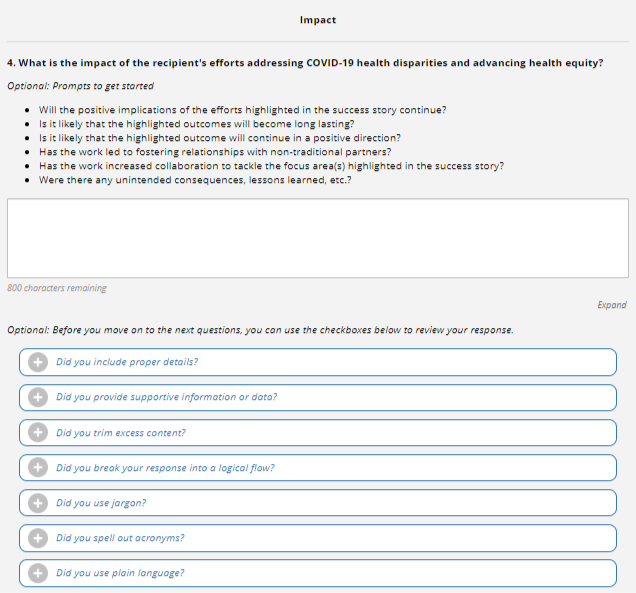

Success Story Support
Submitters may use this section to submit files, hyperlinks and texts to support the story.
Submit Files
After including a file, the submitter should select from the drop-down option column to designate the type of material being included.
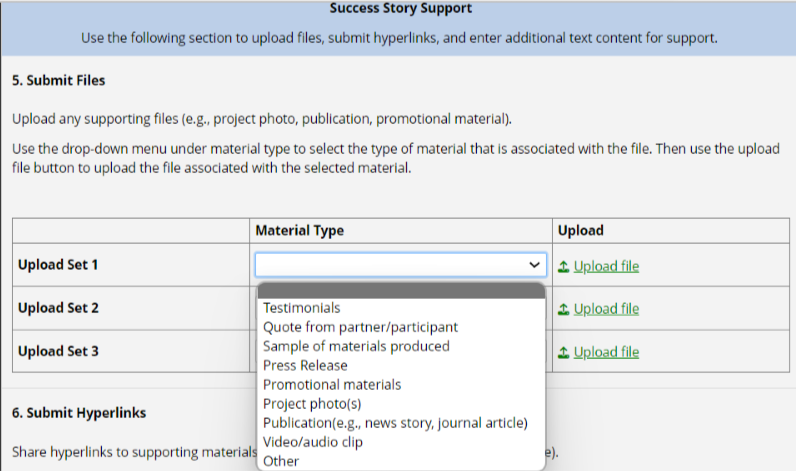
Submit Hyperlinks
After including a hyperlink, the submitter should select from the drop-down option column to designate the type of material being included.
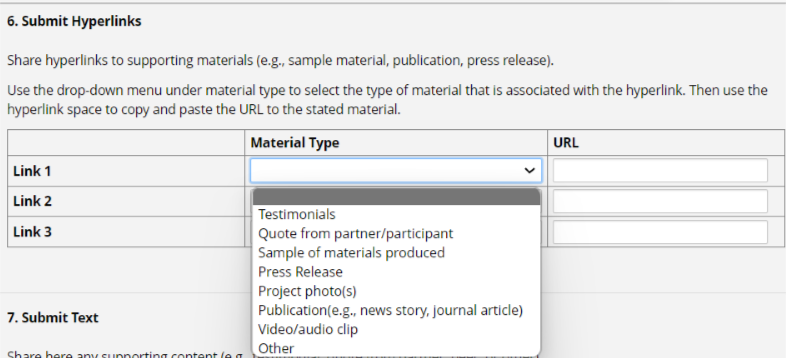
Submit Text
After including text into the open text box field, the submitter should select from the drop-down option column to designate the type of material being included.
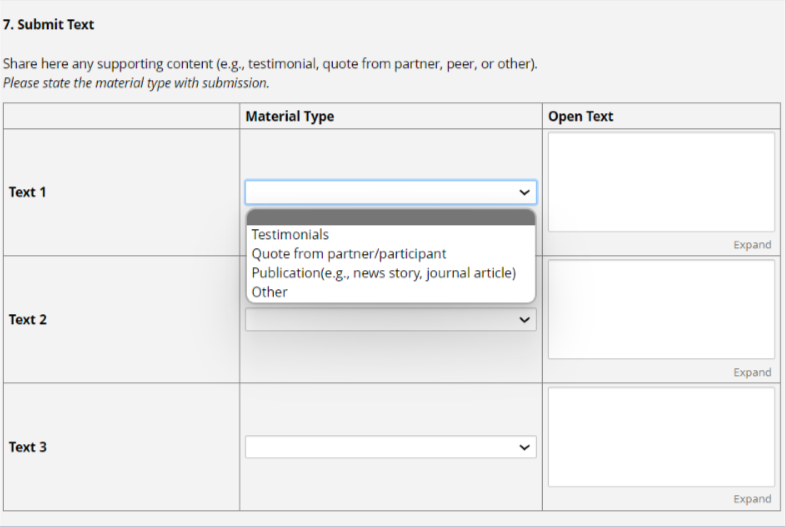
Recipient
Information
Submitters should select from the drop-down to identify the recipient’s name and category related to the success story.

![]()
![]()
OT21-2103
Strategy(ies)
In
this section, submitters should click
![]() to select the strategy(ies) that apply to the success story.
to select the strategy(ies) that apply to the success story.
![]()

If “Strategy 5: other” is selected, a text box will appear to elaborate.

Population(s) of focus
In
this section, submitters should click
![]() to select the population(s) of
focus that apply to the
success story.
to select the population(s) of
focus that apply to the
success story.
If “Other” is selected, a text box will appear to elaborate.
![]()
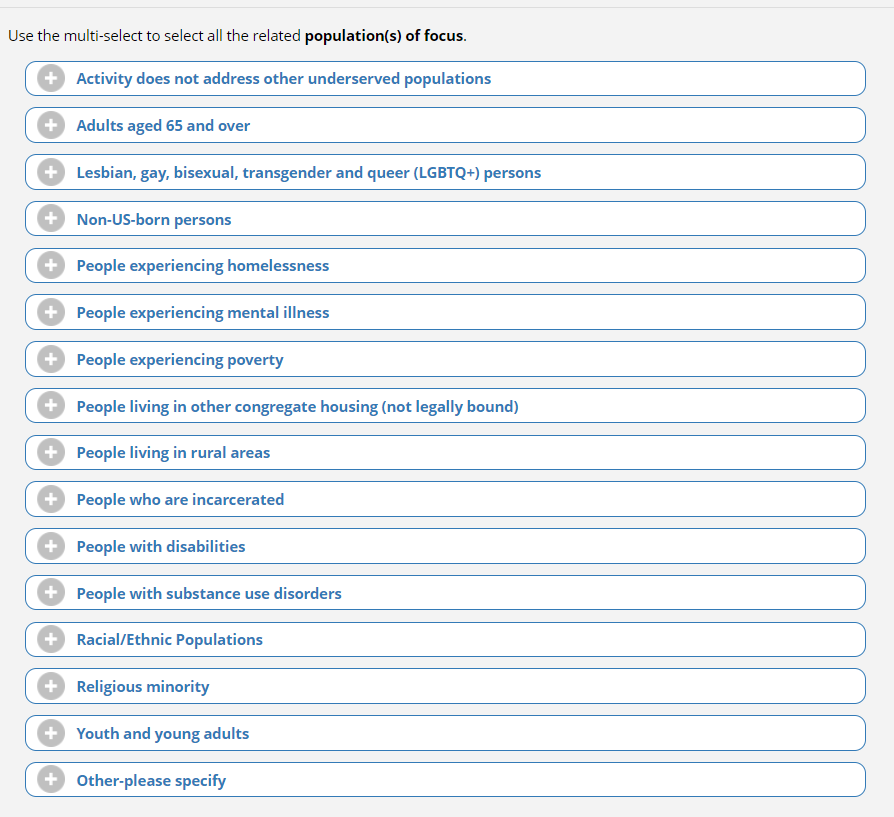
If
“Racial/Ethnic
Populations” is
selected, the following sub drop-down list will appear.

If “Other” is selected, a text box will appear to elaborate.

Activity
Focus Area(s)
In
this section, submitters should click
![]() to select the activity focus
area(s) that apply to the
success story.
to select the activity focus
area(s) that apply to the
success story.
![]()
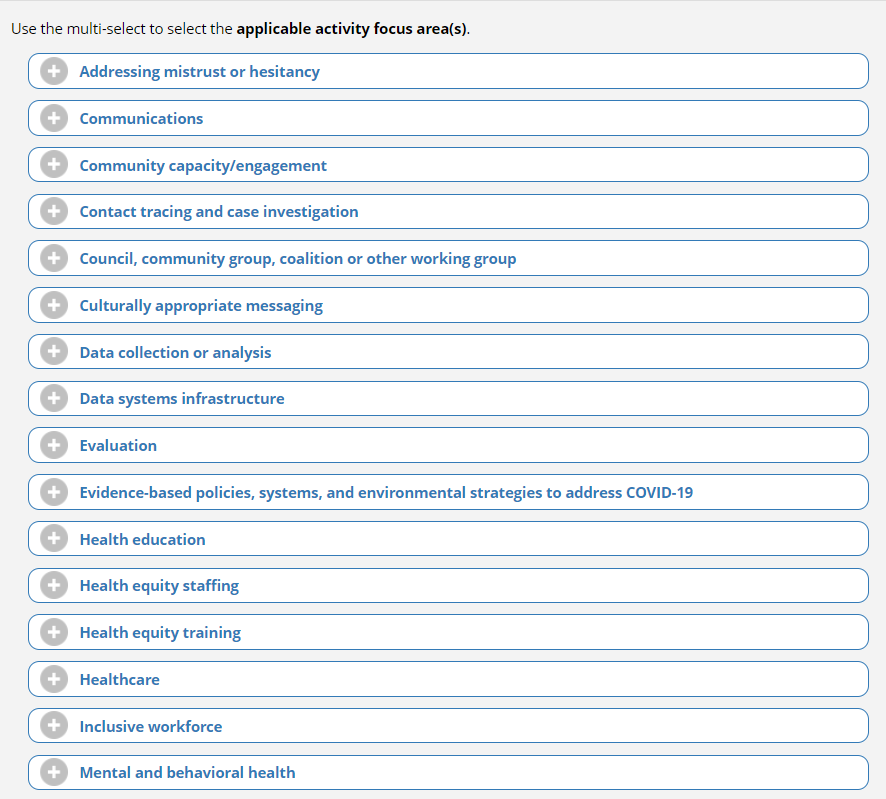
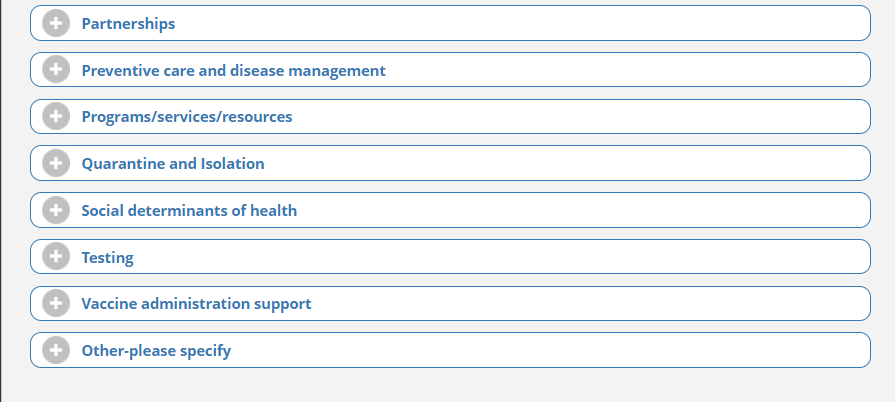
If
“Partnerships”
is selected, a sub-section will appear with multi-select options that
fall under the partnerships focus area. Submitters should click
![]() to all that apply.
to all that apply.
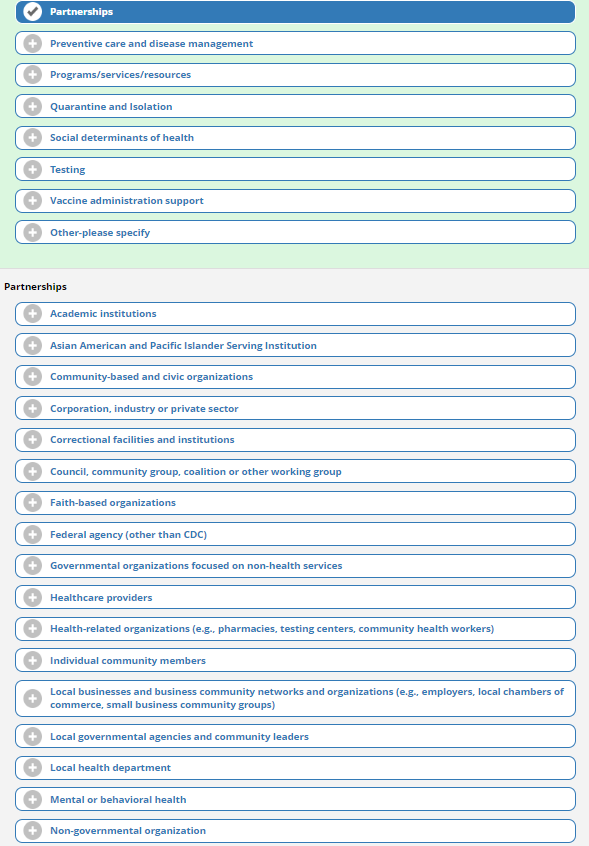

If “Other” is selected under Activity Focus Area, a text box will appear to elaborate.

Submission
Submitters should enter their name and business email address in the designated text boxes.
Submitters have the option to select “Submit” or “Save & Return Later”.



If
you select “Save &
Return”,
a new browser window will appear with a unique
link, like the picture below. With that link, the writer may return
to the working draft, and share with chosen collaborators or
reviewers.
You may copy the unique link and save it somewhere handy.
You may add your email address to send the confirmation email that will include the link as well. This email address must match the email you provided before saving and leaving the previous page (the form).
You also have the option of download a PDF of the current version.
Option
to download a PDF of the working draft
Email
address to receive the link
Unique
link








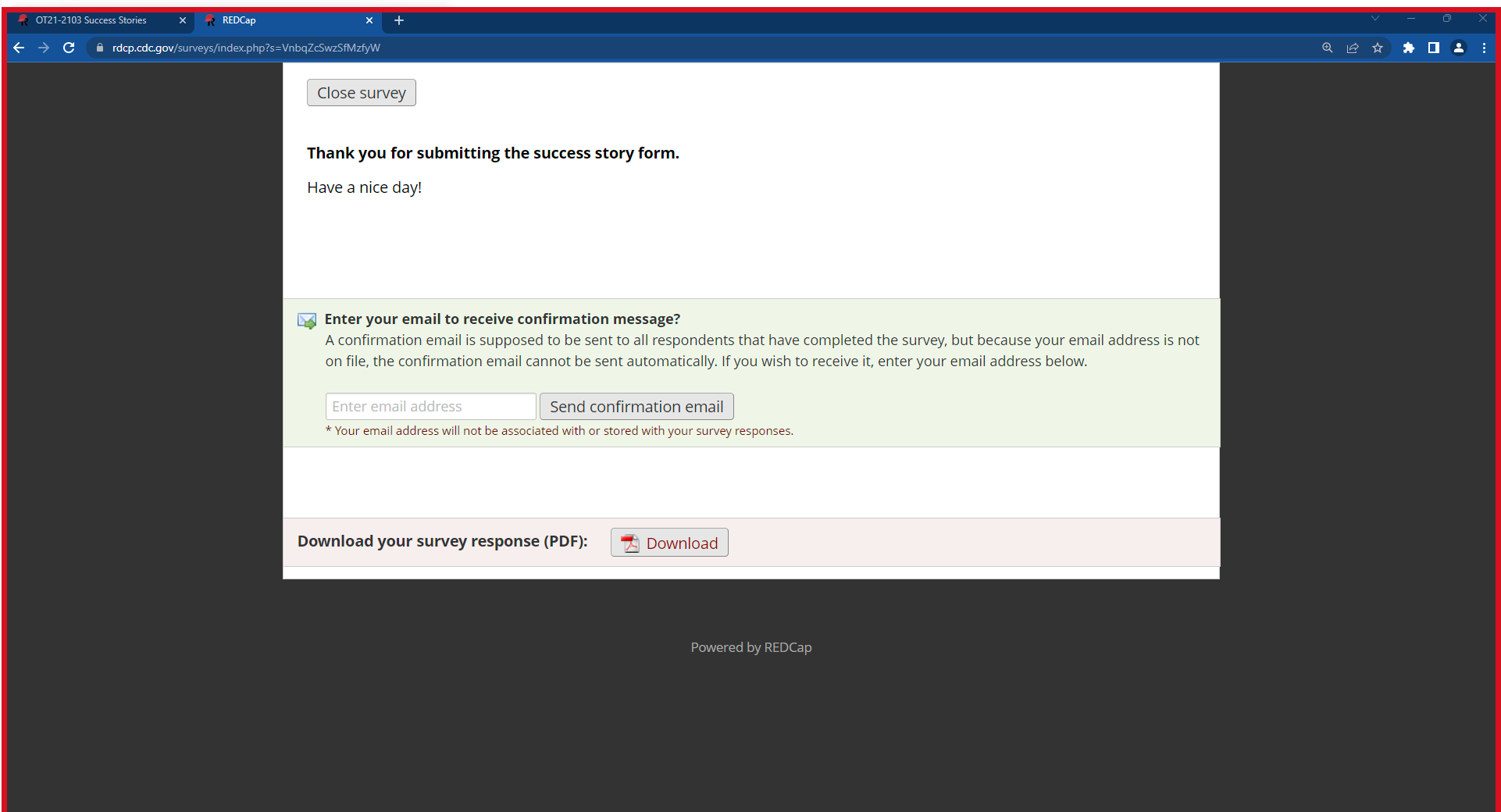
Submitting the Success Story Form
Before clicking submit, please make sure all the information provided in the success story is cleared and reviewed by whoever has the authority at the recipient organization.
Once you click submit, a new window will open and there will be the option to save a PDF of the success story.
An email with the PDF of the success story will be sent to the email address provided in the REDCap form.
What to Expect After Submission
Should the submitter have edits and updates after submission, please contact the project officer, OT21-2103 support team ([email protected]) to notify them. They will help coordinate the steps to incorporate those edits or updates.
The OT21-2103 Program Team will facilitate a review and/or clearance process for the success story.
During the review process, OT21-2103 Program Leadership will determine the internal next steps and application of the success story. See the Application section below for possible paths the success story may take.
Application
The OT21- 2103 Program Team may share a success story to respond to requests for information or to provide examples. These requests can come from internal CDC, media, partners, White House, Congress, etc. The OT21-2103 Technical Assistance Providers may invite submitters to share their stories through other communication opportunities, including blogs, podcasts, and social media.
Support to Submitters
Please contact the OT21-2103 support team ([email protected]) with questions or concerns.
The following OT21-2103 related resources are available:
Specific questions about the workplan, data management plan (DMP), or other programmatic questions: Project Officer
Specific questions about allowable costs, use of funding, and budget: Grants Management Specialist
include the following in the subject line of your email when contacting the GMS: [Recipient Name, Grant Number, Topic]
Questions about performance measures and evaluation: OT21-2103 Evaluation Support at [email protected]
To request technical assistance: please click on this link

| File Type | application/vnd.openxmlformats-officedocument.wordprocessingml.document |
| Author | Ashley Baumann |
| File Modified | 0000-00-00 |
| File Created | 2024-10-28 |
© 2025 OMB.report | Privacy Policy